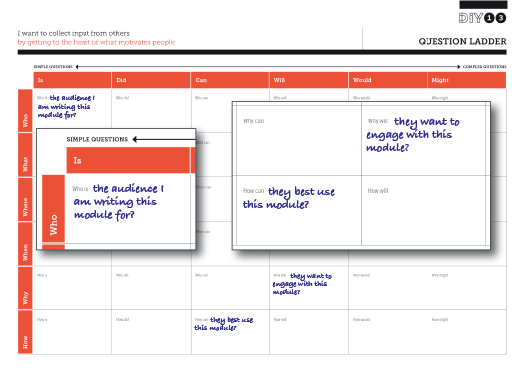Use 'Print preview' to check the number of pages and printer settings.
Print functionality varies between browsers.
Printable page generated Thursday, 13 November 2025, 5:31 PM
Question Ladder
Question Ladder
This module will support your understanding and use of the Question Ladder Tool from the DIY Toolkit. You should look at the Question Ladder Template which can be found on page 60 of the DIY Toolkit before working through the module. You will find it helpful to have a print out of the Question Ladder Template with you while you work through this module.
How do you know the right questions to ask to really get at the information you need? It might sound simple, but focusing on what you’re asking, and how, is essential for improving the quality of the response. ‘Laddering’ is a technique that helps you to focus on a certain topic by asking a series of questions about different aspects related to that topic.
This module shows you how to employ this technique using the Question Ladder Template, a simple tool that enables you to ask ‘good’ questions. (By ‘good questions’, we mean a set of questions that are worth answering, and provide a framework for gathering useful answers for action.)
Learning outcomes
After studying this module, you should be able to:
- describe when a question ladder is a useful and appropriate tool (SAQ 1)
- understand the layout of the Question Ladder Template and how it works (SAQ 2)
- select the most relevant questions to challenge the core issues of a problem or opportunity (SAQ 3)
- explain the strengths and weaknesses of a question ladder (SAQ 4).
1 When to use a question ladder
The question ladder provides a comprehensive approach to questioning an issue that you want to explore. It helps you get at the answers that you did not know you needed, as well as those that you know you need. It also gives you opportunities to ask the same question in different ways, thereby cross-checking and adding validity to the answers, and generating responses that reveal different perspectives on the answer.
Donald Rumsfeld, a former US defence secretary, once said:
There are known knowns. These are things we know that we know. There are known unknowns. That is to say, there are things that we know we don't know. But there are also unknown unknowns. There are things we don't know we don't know.
Rumsfeld was ridiculed for this answer to a question about what was known about terrorist threats (BBC, 2007). However, in our context of considering the questions to ask, the question ladder might also reveal ‘unknown unknowns’, generating questions that we did not know would be useful.

A question ladder is a structured and systematic approach to questioning that enables you to explore an issue from a number of angles. It allows you to approach your knowledge and information needs differently. Rather than starting from ‘What do I need to know?’, and thereby setting limits to what you can discover, the question ladder opens the issue up, allowing you to gain new knowledge and information from a variety of angles.
Key point
A question ladder is a structured and systematic approach to questioning that enables you to explore an issue rigorously.
Activity 1
Can you think of some situations in which a question ladder might be useful to you? (One example might be preparing for a job interview.) How have you prepared your questions before, and why do you think the question ladder may tell you something different? Make some notes in answer to this question in the text box below.
Discussion
You might have chosen a job interview, preparation for an important meeting that you were leading, preparing a project, researching an academic problem, creating a survey, or other similar examples. Essentially, a question ladder might be used whenever you have an important issue to explore from different angles.
Previously, you may have jotted questions down as you thought of them. While this might work well enough most of the time, it is not the most systematic approach. Using the framework of the question ladder allows you to find comprehensive and detailed answers to different questions.
The question ladder can be a tool to help you answer big issues, perhaps even those that keep you awake at night. The question ladder can:
- help you understand your motives for wanting to solve the issue
- enable you to remove yourself from the issue, leading to more objective insights
- enable you to let go of favoured or learned responses in order to understand different behaviours
- help you see different ways of moving forward with the issue.
Asking questions systematically should improve the quality of the answers, and therefore the evidence upon which you plan action.
2 The question ladder approach
The Question Ladder Template is a series of two sets of words that are set out in a grid pattern. From top to bottom, running vertically at the left of the grid, there are question words:
- Who
- What
- Where
- When
- Why
- How
These are sometimes called ‘the five Ws and H’. A useful way of remembering these is Rudyard Kipling’s poem:
I keep six honest serving-men
(They taught me all I knew);
Their names are What and Why and When
And How and Where and Who
...
‘The five Ws and H’ are coupled with question words running horizontally from left to right:
- Is
- Did
- Can
- Will
- Would
- Might
A useful way of remembering these is through a mnemonic. (A ‘mnemonic’ is a way of remembering a phrase or list of things where the initial letter of each word is combined to form a phrase or sentence.) I use the following:
In
Denmark
cats
will
whine
meow.

It is slightly ridiculous of course, but just about makes sense. I remember it because of those two characteristics; if it made perfect sense or was total nonsense I doubt I would remember it.
Activity 2
Looking at the Question Ladder Template, consider the reasons you have decided to study this module. Select three random cells of the template and ask yourself the questions in the context of your motivation for studying the module. Make some notes in answer to these questions in the text box below.
Discussion
I don’t know what cells you selected and the questions you asked yourself, but I randomly chose the following: ‘who is’, ‘why will’ and ‘how can’. Of course, my motivations are different to yours, but these are my questions regarding writing this module.
- Who is the audience I am writing this module for?
- Why will they want to engage with this module?
- How can they best use this module?
They are also shown in Figure 3 below.

2.1 What do the questions mean?
When you start working through the Question Ladder Template, you will notice that some cells in the grid are easier to complete than others. Some will feel irrelevant or clunky, but you should still have a go at filling them in as they will help ensure that you explore the issue from all angles.
Once you have completed all the cells of the Question Ladder Template, you can select the blend of questions that will enable you to get the information and knowledge you need. You should aim to build a chain of questions that gently leads you, or your interviewee, into greater detail and complexity. This will provide a convincing and robust body of evidence for a course of action. You might not need to ask and answer all the questions that you prepared.
You might notice that you have picked certain types of question more than others. For example, you may find that the most useful question types for you are ‘Who’ or ‘Might’ questions, or perhaps they are ‘How’ or ‘Could’ questions.
The frequency of the question types you select can tell you about your concerns around the issue you are investigating. So, for example, ‘Who’ questions suggest you are concerned about responsibility. Look at Table 1 below to see what the different types of question indicate.
| Question type | Concerns | Question type | Concerns | |
| Who? | Responsibility | Is? | Currently | |
| What? | Focus | Did? | Past | |
| Where? | Location | Can? | Ability | |
| When? | Timing | Will? | Motivation | |
| Why? | Rationale | Would? | Possibility | |
| How? | Logistics | Might? | Potential |
3 The question ladder: a case study
In the case study below, Margaret is a young entrepreneur in Uganda who is thinking about a change to her social enterprise. The Question Ladder Template is applied to the case study to demonstrate its application.
Case Study 1: Margaret’s social enterprise
Margaret manages a small social enterprise making costume jewellery from locally produced beads. The enterprise is two years old, and is doing well. At the moment, Margaret employs ten women who work from their own homes assembling the jewellery. While this has worked well, there are limits on how much time the women can give to making the jewellery because of their household commitments. This is holding back expansion of the social enterprise.
Margaret is wondering whether now is the time to seek premises for production and to offer the women part-time or full-time employment outside of the home. She has found a small factory that would accommodate 25 workers. Margaret decides to complete a Question Ladder Template to ensure she is considering everything she needs to. She wants to be as prepared as she can be; this is a big step for her, the workers and the social enterprise.
Activity 3
- a.Margaret has started to complete the question ladder as it applies to her interest in moving the jewellery social enterprise into factory premises. Fill in the empty cells in the half-completed Question Ladder Template below. (Hint: draw on the key aspects of the case study, namely Margaret’s wish for factory premises, retaining existing workers and attracting new workers).
Is | Did | Can | Will | Would | Might | |
Who | Who is using the factory at the moment? | Who can use the factory? | Who will compete to use the factory? | Who would be prepared to work in the factory from my existing workers? | ||
What | What did the factory previously produce? | What will be the critical factors in securing the factory? | What would I have to do to encourage my existing workers to move to the factory? | What might my existing workers feel about the factory? | ||
Where | Where is this factory? | Where did people who worked at the factory come from? | Where can the workers come from? | Where would I look for new workers to expand my workforce? | ||
When | When is this factory used? | When did the previous occupants know they needed to vacate the factory? | When will a decision on the factory’s new occupants be taken? | When would I need to start looking for new workers? | ||
Why | Why is this factory suitable? | Why did the previous occupants vacate the factory? | Why will I be successful in securing this factory? | Why might my existing workers not want to move to the factory? | ||
How | How did the factory become available? For example, leasehold or for sale. | How can my social enterprise make best use of this factory? | How would I train new workers? | How might my existing workers train new workers? |
Discussion
Below is a completed question ladder for Margaret’s wish to move the social enterprise to factory premises. Your answers may not be the same as mine, demonstrating the great variety of questions that can be asked.
Is | Did | Can | Will | Would | Might | |
Who | Who is using the factory at the moment? | Who did the space belong to? | Who can use the factory? | Who will compete to use the factory? | Who would be prepared to work in the factory from my existing workers? | Who might my new workers be? |
What | What is good about this factory? | What did the factory previously produce? | What could the factory be used for? | What will be the critical factors in securing the factory? | What would I have to do to encourage my existing workers to move to the factory? | What might my existing workers feel about the factory? |
Where | Where is this factory? | Where did people who worked at the factory come from? | Where can the workers come from? | Where will a decision on the factory's new occupants be taken? | Where would I look for new workers to expand my workforce? | Where might my new workers live for easy access to the factory? |
When | When is this factory used? | When did the factory’s previous occupants know they needed to vacate the factory? | When can the factory be occupied? | When will a decision on the factory’s new occupants be taken? | When would I need to start to look for new workers? | When might my existing workers start at the new factory? |
Why | Why is this factory suitable? | Why did they vacate the factory? | Why can this factory suit my workers? | Why will I be successful in securing this factory? | Why would my workers want to work in this factory? | Why might my existing workers not want to move to the factory? |
How | How is the factory currently used? | How did the factory become available? For example, leasehold or for sale. | How can the social enterprise make best use of this factory? | How will I pay the rent for this factory? | How would I train new workers? | How might my existing workers train new workers? |
You might feel that some of the questions are asking the same thing. However, they might elicit different answers. For example, 'Where can the workers come from?' sounds the same as 'Where would I look for new workers to expand my workforce?' However, 'Where can' is asking from how far away might women travel to reach the factory; 'Where would' refers to where Margaret might actively recruit new workers. This may be in a specific neighbourhood where she knows there are the requisite skills.
You may have struggled to answer the ‘would’ and ‘might’ questions, as these relate to an unknown future position, and require you to make assumptions in order to make predictions.
4 Strengths and weaknesses of the question ladder

The question ladder provides a structured and systematic approach to building a series of questions, and this is its major strength. Others include versatility (it can be applied to any problem or opportunity), the simplicity of completing the template by following the across-and-down approach, and how the questioning gently becomes more complex – and contested – as you move from left to right across the grid.
However, the disadvantage is that while the question ladder helps you to generate many different questions, some of these questions will be redundant. You will generate questions that you never use, which can be frustrating. In addition to this, while you select the most appropriate questions to seek answers to, this does not necessarily mean that you will be able to gain answers to them and therefore there may be evidence gaps. While having good questions increases the chances that you will gather robust evidence, it does not guarantee it.
As a way of checking and critically reviewing the answers to the questions, it might be helpful to use the DIY Toolkit Evidence Planning Tool which can be found on page 10 of the DIY Toolkit. This will support you in re-examining ‘why you are doing what you do,’ and whether your approach is the best it can be. The tool is a quick way to help reconnect with the goal of your work and improve the chances of realising it.
Activity 4
Reflect on a problem or opportunity of your own, either at home or in the workplace, and complete a Question Ladder Template to help you examine it in more detail. Once you have completed the template, select the questions that you feel are the most relevant to your problem or opportunity. You can choose as many or as few as you need.
Discussion
I hope you found that you were able to complete most of the cells, and then select the questions you felt were the most useful for your problem or opportunity. The process itself might have brought some revelations, and the completed template should help you see where you need to gather more information in order to better understand the issue.
Summary
This module has explained what a question ladder is and when it is a useful and appropriate tool to use. It has described the layout of the Question Ladder Template and how it works. The question ladder was applied to a case study so you could see the practical applications of the tool. This helped reveal the strengths and weaknesses of a question ladder and enabled you to complete the Question Ladder Template for a problem or opportunity you face. It’s important to remember that a question ladder only helps you ask the right questions and, as such, is one step in the wider process of gathering and assessing information and evidence.
Self-assessment questions
SAQ 1
Fill the missing gaps in the sentences below, selecting from the jumbled words.
SAQ 2
What are the two types of questions that are set out in a grid pattern in the Question Ladder Template? Record your answers in the box below.
Discussion
The question ladder is a series of two types of questions that are set out in a grid pattern. From top to bottom, running vertically at the left of the grid, there are the following questions:
- What
- Who
- Where
- When
- Why
- How
The ‘five Ws and H’ are coupled with questions running horizontally from left to right beginning:
- Is
- Did
- Can
- Will
- Would
- Might.
A useful way of remembering these is through a mnemonic.
SAQ 3
In Activity 3, you were asked to select the ten best questions for Margaret’s social enterprise.
SAQ 4
Consider the following statements about the Question Ladder Tool and decide whether they are a strength or weakness.
The question ladder:
a.
Strength
b.
Weakness
The correct answer is a.
a.
Strength
b.
Weakness
The correct answer is b.
a.
Strength
b.
Weakness
The correct answer is b.
a.
Strength
b.
Weakness
The correct answer is a.
a.
Strength
b.
Weakness
The correct answer is b.
a.
Strength
b.
Weakness
The correct answer is a.
a.
Strength
b.
Weakness
The correct answer is b.
a.
Strength
b.
Weakness
The correct answer is a.
Discussion
The strengths and weaknesses of the question ladder would look like this if presented in a table:
| Strengths | Weaknesses |
| Simple to use | Doesn’t always bring answers |
| Gently becomes more complex and contested | No guarantee of good answers |
| Structured and systematic | Has redundancy |
| Versatile | Frustrating |
End of Module Quiz
Congratulations, you have now reached the end of this module! We hope that you have enjoyed it, and have learned useful skills.
End of Module Quiz
This quiz allows you to work towards your badge for DIY Learn: Question Ladder. To achieve your badge, you must answer six out of eight questions correctly.
- You can try each question three times.
- There is no limit to the number of attempts you can have to take the whole quiz.
- If you answer fewer than six questions correctly, you will need to start again if you want to earn your badge.
Don’t worry if you are not successful first time, as you will be able to attempt the quiz again in 24 hours.
You need to enrol in this course before you can attempt this quiz which you can do by clicking on the Sign up / Sign in button at the top of this page.
When you have finished the quiz, click on ‘Next’ to review your ‘Summary of attempt’. Once you are happy with your answers, click ‘Submit all and finish’. Once you have finished this quiz you will be redirected back to this page.
Don’t forget there are another nine modules to choose from which you can find on the DIY Learn home page
References and acknowledgements
Inspired by: Project Innovation (2012) Question. In: Social Innovation Toolkit.
This Module should be cited as follows:
DIY Learn (2016) Question Ladder, Copyright © The Open University and Nesta
Except for third party materials and otherwise stated below, this content is made available under a Creative Commons Attribution-ShareAlike licence (http://creativecommons.org/ licenses/ by-nc-sa/ 4.0/).The material acknowledged below is Proprietary and used under licence for this project, and not subject to the Creative Commons Licence. This means that this material may only be used un-adapted within the DIY Learn project and not in any subsequent OER versions.
Grateful acknowledgement is made to the following sources for permission to reproduce the material in this module:
Figure 1: © Rexfeatures.com
